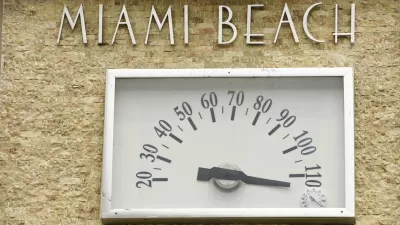Climate change means cities around the world will have to deal with a growing number of heat waves.

Cities heat up faster than rural areas because of heat shields and as global temperatures rise cities must design to mitigate heat waves. "The build-up of heat-trapping greenhouses in the Earth’s atmosphere vastly increases the chances of heat waves, and they are becoming more frequent, more intense, longer, and deadlier," reports Bob Berwyn in Pacific Standard.
The problem of cooling down hot cities is not new and some strategies can still apply. "Since the Middle Ages, and perhaps longer, central squares with fountains and trees have served as urban cooling shelters on hot summer days, and, at the Delft University of Technology, Anna Solcerova is quantifying that cooling effect and studying how modern cities can use water to reduce the effects of extreme heat," Berwyn reports. Rain water or gray water sprinkled on the ground can have a big impact on temperatures. "On hot days, just one liter of water applied over three square meters can cool the air by about two degrees Celsius at head height, and by three degrees Celsius at ground level," Berwyn writes.
FULL STORY: Is Your City Ready for Global Warming’s Coming Heat Waves?

Alabama: Trump Terminates Settlements for Black Communities Harmed By Raw Sewage
Trump deemed the landmark civil rights agreement “illegal DEI and environmental justice policy.”

Planetizen Federal Action Tracker
A weekly monitor of how Trump’s orders and actions are impacting planners and planning in America.

The 120 Year Old Tiny Home Villages That Sheltered San Francisco’s Earthquake Refugees
More than a century ago, San Francisco mobilized to house thousands of residents displaced by the 1906 earthquake. Could their strategy offer a model for the present?

Ken Jennings Launches Transit Web Series
The Jeopardy champ wants you to ride public transit.

BLM To Rescind Public Lands Rule
The change will downgrade conservation, once again putting federal land at risk for mining and other extractive uses.

Indy Neighborhood Group Builds Temporary Multi-Use Path
Community members, aided in part by funding from the city, repurposed a vehicle lane to create a protected bike and pedestrian path for the summer season.
Urban Design for Planners 1: Software Tools
This six-course series explores essential urban design concepts using open source software and equips planners with the tools they need to participate fully in the urban design process.
Planning for Universal Design
Learn the tools for implementing Universal Design in planning regulations.
Clanton & Associates, Inc.
Jessamine County Fiscal Court
Institute for Housing and Urban Development Studies (IHS)
City of Grandview
Harvard GSD Executive Education
Toledo-Lucas County Plan Commissions
Salt Lake City
NYU Wagner Graduate School of Public Service





























